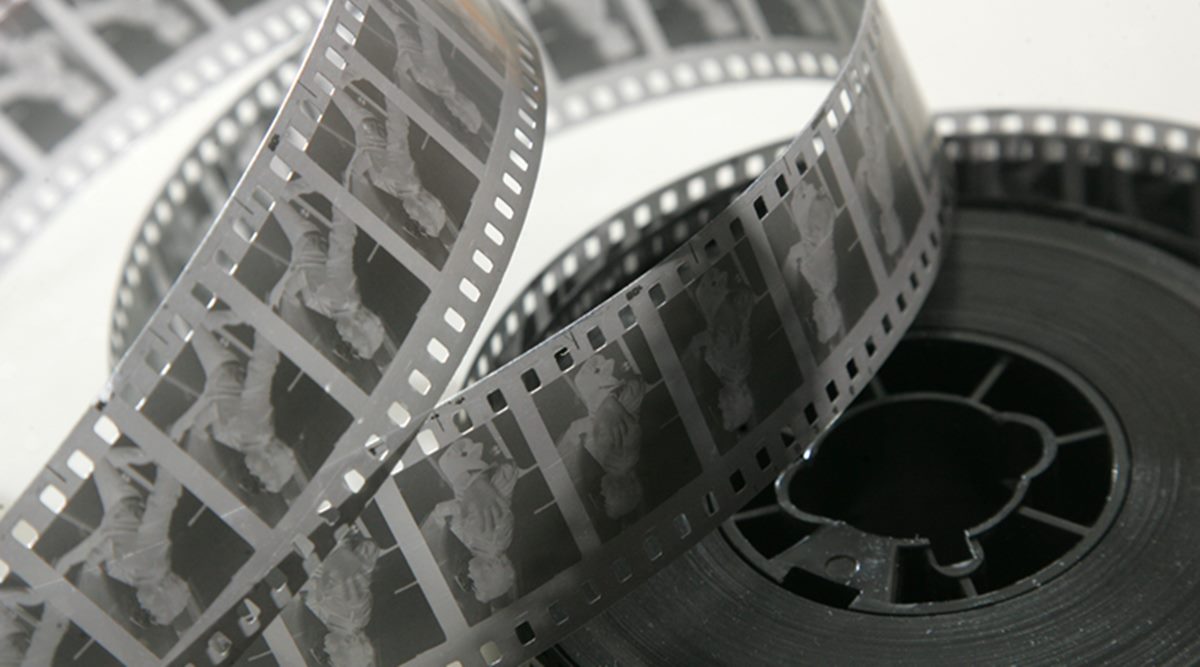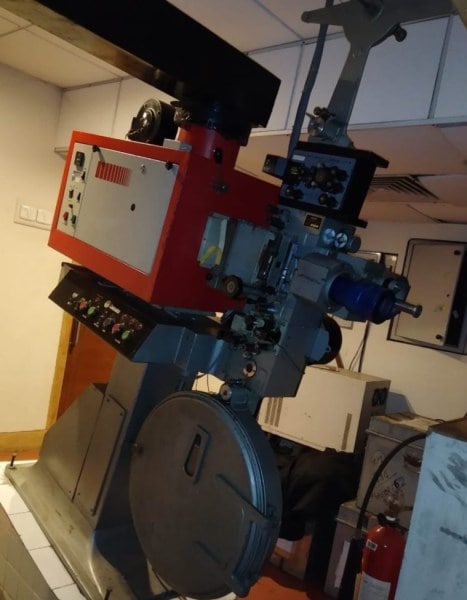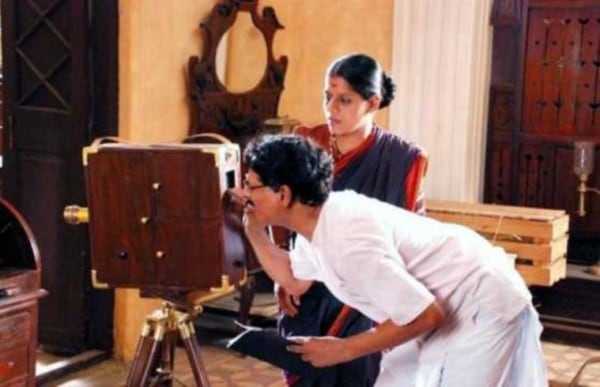 The India Habitat Centre is marking the 75th year of India’s independence with '75 years of Reel Magic — Looking Back with Nostalgia!", a showcase of 35 mm films. (Photo: Wikimedia Commons)
The India Habitat Centre is marking the 75th year of India’s independence with '75 years of Reel Magic — Looking Back with Nostalgia!", a showcase of 35 mm films. (Photo: Wikimedia Commons)Filmmaker Onir had once said in an interview that there are issues with shooting digital, like “that of lighting and the background getting burnt out…shooting landscapes is better with a film camera.” “There’s a certain magic to the graininess and texture of a 35 mm print which those clean chakchak digital prints don’t have. You just couldn’t keep shooting or edit on a computer, you had to cut, paste and layer. It was an arduous process,” says Vidyun Singh, creative head, programmes, at Delhi’s cultural hub India Habitat Centre (IHC). The IHC is marking the 75th year of India’s independence with “75 years of Reel Magic — Looking Back with Nostalgia!”, a showcase of 35 mm films, one from each of the seven decades since, across languages, through the month of August, in collaboration with the Directorate of Film Festivals (DFF).
The 35 mm cinema is history unfolding on screen. “We possibly have the last surviving 35 mm projector in working order in the city or among the projector spaces in use,” says Singh, adding that while IHC is upgraded to fully digital DCPs, their 25-year-old 35 mm projector KPK-23 with Xenon lamp comes alive for monthly screenings, “running the projector is like running an old car, unless it gives up on me, I’m not going to give up on it,” she says.
 The 25-year-old 35 mm projector Cinesales KPK-23 with Xenon lamp. (Photo: Vidyun Singh/India Habitat Centre)
The 25-year-old 35 mm projector Cinesales KPK-23 with Xenon lamp. (Photo: Vidyun Singh/India Habitat Centre) “We are doing decade-wise wrap-up, celebrating the fact that early movies, our heritage, only existed in 35 mm prints. We are ending with a film on the making of our first silent film, by a guy who works with 35 mm,” says Singh.
The choice of movies for this festival was determined by their availability on 35 mm (with DFF). The free-for-all festival commenced on August 1, and will show on the below-mentioned dates, at 6.30 pm, Stein Auditorium, IHC:
Subscriber Only Stories
1940s: Barsaat (Hindi)
 Barsaat (1949). (Photo: Film Still)
Barsaat (1949). (Photo: Film Still) After his directorial debut Aag (1948) tanked, Raj Kapoor’s sophomore catapulted the 25-year-old into a top director, and the youngest such, in the Bombay film industry at the time, and gave him the iconic scene that would become the logo for his production house RK Films. Barsaat (1949), that ignited the Nargis-Kapoor onscreen chemistry, introduced many newcomers in different departments, many of whom would go on to create their own niche, including Ramanand Sagar as the scriptwriter. Barsaat exploits the trope of pahadi girls falling for city babujis and how true love conquers all, albeit after misadventures and a fight that maims, not the villain though. Kapoor, with his car breaking down on winding roads, and his car-pusher friend’s (Prem Nath) escapades and banter could have been a Don Quixote-Sancho Panza exchange in another universe, but this is a plain, bonny love story of simpler times, when love, like the film’s palette, were of just two kinds: black and white, bad and good, lust and love. When: August 1
1950s: Pather Panchali (Bengali)
 Pather Panchali (1955). (Photo: Film Still)
Pather Panchali (1955). (Photo: Film Still) The whole world knows how Satyajit Ray’s Pather Panchali/A Song of the Little Road (1955) put India on the global map, and how, consumed by the radicalism of Vittorio de Sica’s Bicycle Thieves (1948) and good cinema not necessarily requiring experienced actors, rain-free shooting locations, and make-up, he wrote the first draft of his own film onboard the ship carrying him home from London. What the world didn’t know was Bengali filmmakers, over half-century later, would be earning their bread and butter by making poor, rehash copies and adaptations of Ray’s oeuvre. Ray’s debut and filmography is, formidably, the first chapter in the life of every Indian film student. He wrested cinema from being escapist and gave the audiences a reality check. Pandit Ravi Shankar’s scoring for Bibhutibhushan Bandyopadhyay’s humanist story — of a village life, human nature, and juxtapositions of poverty and innocence, as Bhaskar Chattopadhyay observes in his new book The Cinema of Satyajit Ray (Westland) — brought to life with Ray’s pen/vision/direction and Subrata Mitra’s lens, one doesn’t know which marvel to marvel at. Its aesthetics is exquisite in its totality.
When: August 2
1960s: Chemmeen (Malayalam)
 Chemmeen (1965). (Photo: Film Still)
Chemmeen (1965). (Photo: Film Still) In Thakazhi Sivasankara Pillai’s story, adapted into Ramu Kariat-directed Chemmeen (The Prawn, 1965), a fisherman gets a lot of money and becomes selfish. The romance drama explores pitfalls of excessive greed, and a strict social order built around a woman’s chastity, it explores pre-marital and extra-marital relationships, and the adage of seafaring folks, that if a wife crosses the line, the sea shall consume her husband. The 60s counterculture and talks of women’s rights was yet to hit the shores. The film won its Anglo-Indian cinematographer Marcus Bartley the gold medal at the Cannes Film Festival in 1978.
When: August 3
1970s: Ankur (Hindi)
 Ankur (1974). (Photo: Film Still)
Ankur (1974). (Photo: Film Still) In his feature debut, director Shyam Benegal (whose next film will be the India-Bangladesh collaboration, Mujib), puts a woman (Shabana Azmi) at the centre of the vortex of class, caste and gender politics in feudal, rural India. The actors, Azmi’s and Anant Nag’s debut, as a married peasant girl in an illicit affair with the landlord’s son, respectively, are each a landscape unto themselves, and the film is scaffolded upon myriad contradictions, such as a liberal, city-educated, upper-caste man opts for a Dalit woman as a cook, instead of a priest, but agrees to a child bride for himself. The critically acclaimed back-to-the-roots social-realist film Ankur (1974), also a commercial hit, shot by then debutant cinematographer Govind Nihalani, gave Benegal the tag of a parallel-cinema maker, one that would be stuck for life. Benegal, then a documentary filmmaker, apparently carried the film’s script for 13 years before he found investors, Mohan Bijlani and Freni Variava, who invested Rs 5 lakh and the three started a production-distribution company together called Blaze Enterprises, writes OP Srivastava in his recently released book Pillars of Parallel Cinema: 50 Path-Breaking Hindi Films (2022).
When: August 16
1980s: Jaane Bhi Do Yaaro (Hindi)
 Jaane Bhi Do Yaaro (1983). (Photo: Film Still)
Jaane Bhi Do Yaaro (1983). (Photo: Film Still) Srivastava writes, in his book, how Kundan Shah’s 1983 black comedy debut was inspired by two aspects: a real-life incident involving two of his FTII batchmates who, for the lack of work, opened a photo studio in Hyderabad, and Michelangelo Antonioni’s film Blow-Up (1966). The Antonioni Park in the film was a hat tip to the latter. In his book, Jaane Bhi Do Yaaro: Seriously Funny Since 1983 (2010), Jai Arjun Singh writes, “…Kundan wasn’t too interested in the ‘slapstick side’ at the time he was writing the script. In fact, he shows an almost indifferent attitude to the physical comedy in the Vinod-Ashok (Naseeruddin Shah-Satish Kaushik) phone mix-up, assuming that the actors would easily manage it when the time came. What he really relished writing was the political commentary in a farcical phone conversation involving a fake Margaret Thatcher and a fake Ronald Reagan.” The film, most obviously, was a satire on capitalism, consumerism, bureaucracy, real estate, media, and politics. “It was the first satirical Hindi comedy that was not slapstick,” Srivastava writes. From today’s time, looking back, it seems a marvel that the film was produced by NFDC, which once provided smaller, parallel films, enough teeth to bite with.
When: August 19
1990s: Roja (Tamil)
 Roja (1992). (Photo: Film Still)
Roja (1992). (Photo: Film Still) AR Rahman was introduced to Hindi-film audiences with the dubbed version of Mani Ratnam’s 1992 Tamil romantic thriller, and romantic music, or music for that matter, would never be the same again. In a way this film was, perhaps, the first to bridge the north-south cinematic divide, not just for the audiences but for the film’s subjects too. Roja was, perhaps, the first dubbed film to break the regional barrier, become a hit, and make Rahman, Ratnam, and his DOP Santosh Sivan to belong not just to Madras (now Chennai) but to the whole country. Ratnam’s “career is one that pivots around Roja,” writes Baradwaj Rangan in his book, Conversations with Mani Ratnam (2012). The film was a good example of a film with a patriotic theme championing the freedom of speech. Those were distant times, both in real and reel life.
When: August 29
2000s: Harishchandrachi Factory (Marathi)
 Harishchandrachi Factory (2009). (Photo: Film Still)
Harishchandrachi Factory (2009). (Photo: Film Still) The debutant director Paresh Mokashi-helmed 2009 biographical feature film trains the lens on the father of Indian cinema, Dadasaheb Phalke, and his making of, as is officially recognised, India’s first full-length feature film and first silent film, Raja Harishchandra (1913). Though supporters of Dadasaheb Torne’s London-processed Shree Pundalik (1912) would beg to differ, but it was, by some accounts, photographic recording of a Marathi play. Harishchandrachi Factory takes a peek into Phalke’s fascination for the moving image, the 35 mm film and projector, and the arduous task of the making of Raja Harishchandra. This is where it all began.
When: August 30
- The Indian Express website has been rated GREEN for its credibility and trustworthiness by Newsguard, a global service that rates news sources for their journalistic standards.

